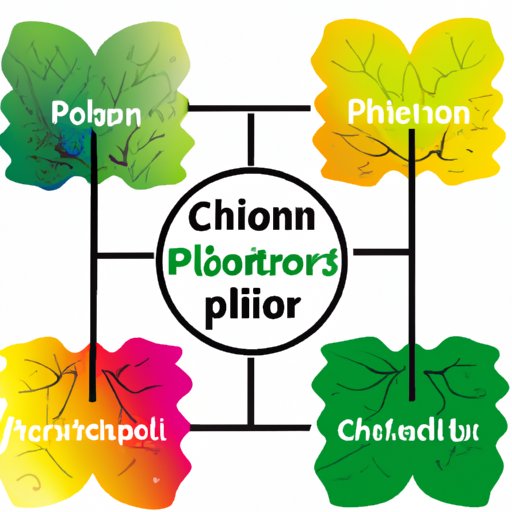I. Introduction
Photosynthesis, the process by which plants harness the energy of sunlight to create food molecules, is one of the most important biological processes on the planet. At the heart of this process are plant pigments, which absorb light energy and harness it to fuel the creation of sugars and other organic compounds. Understanding the role of these pigments is essential to understanding how plants grow and survive, as well as to exploring their potential for new technologies based on renewable energy.
II. Understanding Plant Pigments and their Role in Photosynthesis
Plant pigments are organic molecules that absorb certain wavelengths of light. These pigments are essential to photosynthesis because they are able to capture light energy and use it to power the creation of ATP and NADPH, two molecules that are used to produce organic compounds. These pigments are located in chloroplasts, which are organelles that are specialized for capturing light energy. Within chloroplasts, pigments are located on thylakoid membranes, which are highly organized structures that maximize light absorption.
The basic equation for photosynthesis is as follows: 6CO2 + 6H2O + light energy → C6H12O6 + 6O2. This equation shows how pigments, in conjunction with other molecules and structures in plant cells, are able to transform light energy into chemical energy that can be used by plants to fuel their metabolism and growth.
III. Importance of Pigments in Harnessing Light Energy for Plant Growth and Survival
Photosynthesis and pigment utilization allow plants to use light energy to form food molecules that are essential to their growth and survival. These food molecules include glucose, which is used to fuel cell metabolism, and cellulose, which is used to build cell walls and provide structural support to the plant. Through photosynthesis and pigment utilization, plants are able to convert raw materials like carbon dioxide, water, and light energy into complex organic compounds that are essential to their existence.
Pigments also enable plants to adapt to different light conditions. For example, chlorophyll pigments are optimized for light absorption at certain wavelengths, allowing plants to maximize their energy harvesting in different environments. Additionally, other pigments such as carotenoids and phycobilins provide additional light harvesting capacity and act as photoprotective molecules, shielding the plant from excess light energy that can damage cellular structures.
IV. An In-Depth Analysis of the Various Types of Pigments Involved in Photosynthesis
There are several different types of pigments present in plant cells, each with its unique structure and function. Chlorophyll is the most abundant and important of these pigments, helping plants to absorb blue and red wavelengths of light and convert them into energy. Other pigments, like carotenoids and phycobilins, are also important for photosynthesis and contribute to both energy harvesting and photoprotection.
Chlorophyll a and chlorophyll b are the two most important types of chlorophyll pigments. Chlorophyll a is involved in the initial energy conversion reactions and is responsible for the dominant green color of most plants. Chlorophyll b is able to absorb light at slightly longer wavelengths than chlorophyll a and is used to complement the energetic capabilities of chlorophyll a. Together, these pigments allow plants to absorb energy from a wide variety of light wavelengths and convert it into usable energy.
V. A Comparative Study of Chlorophyll and its Alternatives in Photosynthesis
While chlorophyll a and b are the most important photosynthetic pigments used by plants, many other organisms have evolved different strategies for harnessing light energy. For example, some photosynthetic bacteria use alternative pigments like bacteriochlorophyll and bacteriorhodopsin to absorb light energy and create ATP and other energy-rich compounds. These pigments operate at different wavelengths than chlorophyll and have unique energy conversion mechanisms.
VI. Understanding the Role of Pigments in Regulating Plant Responses to Environmental Stressors
Plants are able to adjust their pigment composition to adapt to different light conditions or stressors, such as drought or extreme temperatures. This allows plants to optimize energy harvesting and photoprotection and maintain their growth and survival under challenging conditions. One of the most important adaptations that plants make in response to stress is photoprotection, which involves the synthesis and accumulation of photoprotective pigments like carotenoids and zeaxanthin. These pigments protect the plant from excess light energy and prevent damage to cellular structures.
Pigments also play a role in regulating plant growth and defense mechanisms. Some pigments, like anthocyanins, regulate the growth and development of plant organs like leaves and flowers. Others, like flavonoids, are involved in the plant’s defense against pathogens and herbivores.
VII. Exploring the Potential of Plant-Pigment Based Technologies for Renewable Energy Production
Plant pigments have the potential to be used in technologies based on photosynthesis, such as biofuels and solar cells. By engineering plants to optimize pigment utilization and energy conversion, it may be possible to create more efficient and sustainable energy sources. Additionally, research into the mechanisms of photosynthesis and pigment utilization could help to unlock new energy conversion strategies that are inspired by natural processes.
VIII. Conclusion
Plant pigments play an essential role in photosynthesis and are key to the growth and survival of plants. Understanding the types and functions of pigments can provide insights into how plants are adapted to different environmental conditions and how they are able to produce food and energy. Further research into the potential of plant-pigment based technologies could lead to a more sustainable future.
